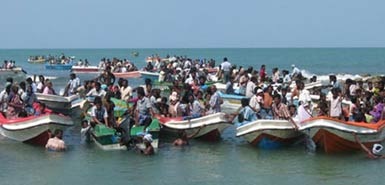 At a recent meeting with foreign ambassadors, the man running Sri Lanka’s war against the Tamil Tigers was asked how he planned to handle the tens of thousands of civilians trapped inside a no-fire zone with the rebels.
At a recent meeting with foreign ambassadors, the man running Sri Lanka’s war against the Tamil Tigers was asked how he planned to handle the tens of thousands of civilians trapped inside a no-fire zone with the rebels.
Gotabaya Rajapaksa, the Defence Secretary and brother of the President, Mahinda Rakapaksa, replied that he was inspired by Russia’s handling of the Beslan school siege in 2004.
This was either a misguided attempt to flatter the Russian Ambassador, or a chilling foretaste of what could happen in the next few days. I covered Beslan for The Times and it was a bloodbath — out of 1,100 hostages, 344 were killed, half of them children — due in large measure to the incompetence of the Russian security services. Even Russian officials admit it was a disaster.
Whatever Mr Rajapaksa’s intentions, any comparison is an extraordinary way to try to reassure the international community that Sri Lankan forces will limit civilian casualties in the final battle of this 26-year civil war.
Sri Lanka’s troops are better prepared for this operation than the Russians were in Beslan, but the challenge is equally complicated and on a much larger scale. Troops have to kill or capture the last 200 core Tiger fighters, plus several hundred recent recruits, while keeping civilian casualties to a minimum and making sure that the rebels do not escape with the non-combatants.
All that in a 5sq mile (13sq km) sliver of beach and coconut grove, crammed full of makeshift shelters that until Monday were housing 100,000- 150,000 civilians, according to the UN and the Red Cross.
The army now says that it has freed more than 80,000 of them (even though it said previously that there were fewer than 50,000 there all together) and has yet to mount it final attack on the Tamil Tigers. It also says it is using only light weapons to minimise civilian casualties.
The problem is that, unlike in Beslan, there are virtually no independent witnesses to verify the army’s claims — and the few Red Cross and UN staff on the ground often dispute them (as with the figures for civilians).
For most of the past two years, the Sri Lankan Government has banned almost all independent reporters and aid workers from the front line: The Times has not been granted a journalist’s visa to Sri Lanka since August.
The Government says that it imposes these restrictions because many Western journalists, aid workers and even diplomats secretly support the Tigers, banned as a terrorist organisation in the European Union, America and India.
The vast majority actually support the goal of defeating the Tigers, who have forcibly recruited children, pioneered the use of suicide bombs, used civilians as human shields, and killed thousands of innocent people. But they also believe in scrutinising both sides of any conflict, and holding a democratically elected government — and member of the Commonwealth — to higher standards than those of a terrorist organisation.
That is why the Government needs to allow more reporters and aid workers to witness the civilians’ exodus from the no-fire zone, to speak to them directly and to see how they are being treated in the camps where they are being sent. By blocking such scrutiny, the Government simply undermines its own moral legitimacy and makes it harder to convince the world of its successes — even as the Tigers and others highlight its failures.
It also risks damaging its relations with the international community of democracies (still its main aid donors and trading partners) and radicalising not only its own three million Tamils, but the 74 million-strong Tamil diaspora, from which a new armed movement could easily emerge.
(For updates you can share with your friends, follow TNN on Facebook and Twitter )
